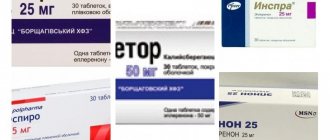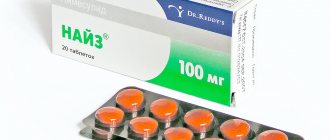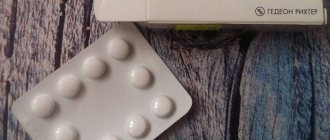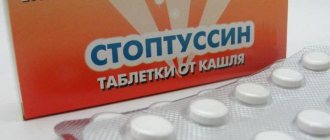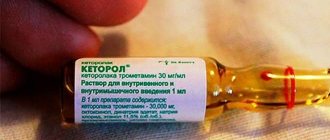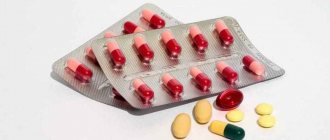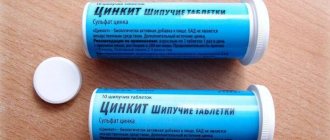| This article violates the rule against instructions in encyclopedia articles. Its text almost completely repeats the instructions for use of the drug provided by its manufacturer. In addition, the data provided may not be sufficiently objective and reliable (especially regarding the effectiveness and safety of the drug). To maintain neutrality of presentation, it is necessary to rework this article based on independent authoritative sources of information. |
| Alimemazine | |
| Alimemazinum | |
| Alimemazine | |
| Chemical compound | |
| IUPAC | N , N ,β-Trimethyl-10H - phenothiazine-10-propanamine (and as tartrate) |
| Gross formula | C₁₈H₂₂N₂S |
| Molar mass | 298.447 g/mol |
| CAS | 84-96-8 |
| PubChem | 5574 |
| DrugBank | APRD00258 |
| Classification | |
| ATX | D04AA10 R06AD02, R06AD05 |
| Pharmacokinetics | |
| Metabolism | in the liver |
| Half-life | 5 o'clock |
| Dosage forms | |
| ampoules, film-coated tablets, drops | |
| Other names | |
| Alimemazine tartrate, Teraligen, Teralen, Alimezine, Isobutrazine, Methylpromazine, Nedeltran, Panectyl, Repeltin, Temaril, Theralen, Trimeprazine, Vallergan | |
| Alimemazine at Wikimedia Commons | |
Alimemazine
(trimeprazine, trade names
Teralen
,
Teraligen
) is an antipsychotic drug with antihistamine, antispasmodic, dopamine-blocking and moderate α-adrenergic blocking effects; In addition, it has antiemetic, hypnotic, sedative and antitussive effects.
Its chemical structure is similar to promethazine and levomepromazine. It differs from promethazine by the presence of an additional methylene group (CH2) in the side chain, and from levomepromazine by the absence of an OCH3 group in position 2 of the phenothiazine core.
Pharmacologically, it occupies an intermediate position between promethazine, which is an antihistamine with sedative activity, and the antipsychotic drug chlorpromazine. It is more active in antihistamine and sedative action than promethazine, and has properties characteristic of chlorpromazine and other phenothiazine antipsychotics. Compared to chlorpromazine, it has a less pronounced adrenergic blocking effect; has weak anticholinergic activity.
Content
- 1 Physical properties
- 2 Pharmacological action
- 3 Pharmacokinetics
- 4 Indications
- 5 Dosage regimen
- 6 Contraindications 6.1 With caution
- 7.1 From the nervous system
pharmachologic effect
Antipsychotic drug (neuroleptic), has antihistamine, antispasmodic, serotonin-blocking and moderate α-adrenergic blocking effects, as well as antiemetic, hypnotic, sedative and antitussive effects. The antipsychotic effect is due to the blockade of dopamine D2 receptors of the mesolimbic and mesocortical systems. The sedative effect is due to the blockade of adrenergic receptors in the reticular formation of the brain stem; antiemetic effect - blockade of dopamine D2 receptors in the trigger zone of the vomiting center; hypothermic effect - blockade of dopamine receptors of the hypothalamus. The onset of the effect is after 15-20 minutes, the duration of action is 6-8 hours.
Directions for use and doses
The drug should be taken orally, dividing the daily dose into 3-4 doses.
The onset of action of the drug is after 15-20 minutes, the duration of action is 6-8 hours.
For adults, to achieve a hypnotic effect, 5-10 mg/day; to achieve an anxiolytic effect, 60-80 mg/day.
Children over 7 years of age (depending on age and body weight) to achieve a hypnotic effect, 2.5-5 mg/day; as a symptomatic treatment of allergic reactions, 5-20 mg/day; to achieve an anxiolytic effect, 20-40 mg/day; in psychotic conditions, it is possible to increase the daily dose of the drug to 60 mg/day.
Indications
Alimemazine is a moderately active antipsychotic. For severe psychoses it is relatively ineffective; acts primarily as a mild sedative and anti-anxiety agent, has a positive effect on senesthopathy, obsession and phobia. It is used mainly for psychosomatic manifestations that develop due to vascular traumatic, somatogenic, infectious dysfunctions of the central nervous system and for neurovegetative disorders. The sedative effect helps normalize sleep in patients in this category.
Due to its antihistamine activity, alimemazine is also used for allergic diseases, especially the respiratory tract, and for itchy skin. Soothes cough and has antiemetic activity.
Due to its relatively good tolerance, it is used in pediatric and gerontological practice, as well as in somatic medicine.
Indications for use
- neuroses and neurosis-like conditions of endogenous and organic origin with a predominance of senestopathic, hypochondriacal, phobic and psychovegetative disorders;
- psychopathy with asthenic and psychoasthenic disorders;
- anxiety-depressive conditions within the framework of borderline endogenous and vascular diseases;
- senestopathic depression;
- somatized mental disorders;
- states of excitement and anxiety in somatic diseases;
- sleep disorders of various origins;
- allergic reactions (symptomatic treatment).
Contraindications
Hypersensitivity, angle-closure glaucoma, prostatic hyperplasia, severe hepatic and/or renal failure, parkinsonism, myasthenia gravis, Reye's syndrome, simultaneous use of MAO inhibitors (including furazolidone, linezolid, etc.), pregnancy, lactation.
With caution
Alcoholism (history of complications when using phenothiazine drugs), bladder neck obstruction, predisposition to urinary retention, epilepsy, open-angle glaucoma, jaundice, bone marrow suppression, arterial hypotension.
Teraligen
Active substance:
Aimemazine* tartrate
Pharmgroup:
Neuroleptics
Average price in pharmacies
| Name | Manufacturer | average price |
| Teraligen valence 0.005 n100 tablet p/film/coating | VALENTA PHARMACEUTICS | 1387.00 |
| Teraligen valence 0.005 n25 tablet p/film/coating | VALENTA PHARMACEUTICS | 632.00 |
| Teraligen valence 0.005 n50 tablet p/film/coating | VALENTA PHARMACEUTICS | 820.00 |
| Teraligen retard 0.02 n30 tablet prolong release p/capt/coating | VALENTA PHARMACEUTICS | 1412.00 |
Analogs for the active substance:No data on synonyms | Application area:Agitation Anxiety Explosive excitability Internal excitement Excitability Excitation Excitement is acute Psychomotor agitation Generalized anxiety Generalized anxiety disorders Hyperexcitability Motor excitement Depression with anxiety-depressive components Dissociative phenomena Hypochondriacal-senestopathic syndrome Hypochondriacal disorders Hypochondriacal neurosis Hypochondriacal and asthenohypochondriacal condition Hypochondriacal and asthenohypochondriacal condition Hypochondria Cardioneurosis Conversion disorders Conversion symptoms Relief of psychomotor agitation Neurosis Neurological diseases Neurotic disorders Neurotic state Nervous excitement Restlessness Night restlessness Organic asthenodepressive disorder Acute stage of schizophrenia with agitation Acute mental agitation Paroxysm of excitement Overexcitement Increased excitability Increased nervous excitability Increased emotional and cardiac excitability Increased arousal Pseudo-dementia Mental excitement Psychoasthenia-like disorder Psychogenic psychosis Psychomotor agitation Psychomotor agitation Psychomotor agitation Psychomotor agitation in psychosis Psychomotor agitation of an epileptic nature Psychomotor paroxysm Psychomotor seizure Psychoneurosis Psychosomatic diseases Psychosomatic disorders Psychosomatic disorder Senesto-hypochondriacal disorders Senesto-hypochondriacal disorders Cardiovascular neurosis Symptoms of arousal Symptoms of psychomotor agitation Neurocirculatory dystonia syndrome Mixed anxiety and depression Somatovegetative disorder Somatovegetative complications State of agitation State of anxiety State of excitement A state of heightened anxiety State of psychomotor agitation States of anxiety States of arousal State of agitation in somatic diseases State of agitation in somatic diseases State of excitement Anxious depression Anxious reaction Anxious-depressive mood Anxiety and depression Anxiety and depression Anxiety-depressive syndrome Anxiety-neurotic conditions Anxiety-neurotic conditions Anxiety neurosis Phobic neurosis Functional psychosomatic disorders of the cardiovascular system Chronic neurotic disorders Feeling restless Emotional excitement Emotional reactive disorders |
Side effects
From the nervous system
Drowsiness, lethargy, fatigue; paradoxical reaction (anxiety, agitation, “nightmare” dreams, irritability); extrapyramidal disorders (tremor, akathisia, parkinsonism)[1]; rarely - confusion, increased frequency of sleep apneas, increased seizure activity (in children).
From the senses
Blurred vision (accommodative paresis), noise or ringing in the ears.
From the cardiovascular system
Dizziness, decreased blood pressure, tachycardia.
From the digestive system
Dry mouth, gastrointestinal atony, constipation, loss of appetite.
From the respiratory system
Dry nose, throat, increased viscosity of bronchial secretions.
From the urinary system
Bladder atony, urinary retention.
Others
Allergic reactions, agranulocytosis[1], increased sweating, muscle relaxation, photosensitivity.
special instructions
With long-term treatment, it is necessary to systematically conduct a general blood test and evaluate liver function. May mask the ototoxic effects (tinnitus and dizziness) of co-administered medications. Increases the need for riboflavin. To prevent distortion of the results of skin prick tests for allergens, it is necessary to cancel 72 hours before allergy testing. During treatment, false positive pregnancy test results are possible. The solution for infusion contains inorganic sulfites, which can cause anaphylactic reactions. During treatment, you should not engage in activities that require increased attention. During treatment you should not consume ethanol.
Interaction
Enhances the effects of narcotic analgesics, hypnotics, anxiolytic (tranquilizers) and antipsychotic drugs (neuroleptics), as well as drugs for general anesthesia, m
- anticholinergics and antihypertensive drugs (dose adjustment required).
Weakens the effect of amphetamine derivatives, m
-cholinomimetics, ephedrine, guanethidine, levodopa, dopamine.
Combined use with ethanol and drugs that suppress the action of the central nervous system leads to increased depression of the central nervous system. Antiepileptic drugs and barbiturates reduce the threshold for seizure activity (dose adjustment required). Beta-blockers increase (mutually) plasma concentrations (a pronounced decrease in blood pressure and arrhythmias are possible). Weakens the effect of bromocriptine and increases the concentration of prolactin in the blood serum. Tricyclic antidepressants and anticholinergic drugs enhance m
-cholinolytic activity. MAO inhibitors (simultaneous administration is not recommended) and phenothiazine derivatives increase the risk of arterial hypotension and extrapyramidal disorders. When alimemazine is co-administered with drugs that inhibit bone marrow hematopoiesis, the risk of myelosuppression increases. Hepatotoxic drugs increase the manifestations of hepatotoxicity of the drug.
Alimemazine
International name of the medicinal substance:
Alimemazine The list of drugs containing the active substance Alimemazine is given after the description.
Pharmacological action:
Antipsychotic drug (neuroleptic), has antihistamine, antispasmodic, serotonin-blocking and moderate alpha-adrenergic blocking effects, as well as antiemetic, hypnotic, sedative and antitussive effects.
The antipsychotic effect is due to the blockade of dopamine D2 receptors of the mesolimbic and mesocortical systems. The sedative effect is due to the blockade of adrenergic receptors in the reticular formation of the brain stem; antiemetic effect - blockade of dopamine D2 receptors in the trigger zone of the vomiting center; hypothermic effect - blockade of dopamine receptors of the hypothalamus. The onset of the effect is after 15-20 minutes, the duration of action is 6-8 hours. Pharmacokinetics:
Connection with plasma proteins - 20-30%, T1/2 - 3.5-4 hours. Excreted by the kidneys - 70-80% in the form of a metabolite (sulfoxide ).
Indications:
Neurotic, neurosis-like and psychopath-like states, anxiety-depressive state (as part of borderline endogenous and vascular diseases), insomnia (of various origins).
Allergic reactions (symptomatic treatment). Contraindications:
Hypersensitivity, angle-closure glaucoma, prostatic hyperplasia, severe hepatic and/or renal failure, parkinsonism, myasthenia gravis, Reye's syndrome, simultaneous use of MAO inhibitors, pregnancy, lactation.
Side effects:
From the nervous system: drowsiness, lethargy, fatigue;
paradoxical reaction (anxiety, agitation, “nightmare” dreams, irritability); rarely - confusion, extrapyramidal disorders (hypokinesia, akathisia, tremor); increased frequency of night apnea, increased seizure activity (in children). From the senses: blurred visual perception (accommodation paresis), noise or ringing in the ears. From the cardiovascular system: dizziness, decreased blood pressure, tachycardia. From the digestive system: dryness of the oral mucosa, gastrointestinal atony, constipation, loss of appetite. From the respiratory system: dry nose, throat, increased viscosity of bronchial secretions. From the urinary system: bladder atony, urinary retention. Other: allergic reactions, inhibition of bone marrow hematopoiesis, increased sweating, muscle relaxation, photosensitivity. Interaction:
Enhances the effects of narcotic analgesics, hypnotics, anxiolytic (tranquilizers) and antipsychotic drugs (neuroleptics), as well as drugs for general anesthesia, m-anticholinergic drugs and antihypertensive drugs (dose adjustment required).
Weakens the effect of amphetamine derivatives, m-cholinergic stimulants, ephedrine, guanethidine, levodopa, dopamine. Ethanol and drugs that suppress the action of the central nervous system - central nervous system depression. Antiepileptic drugs and barbiturates reduce the threshold of convulsive activity (dose adjustment required). Beta-blockers increase (mutually) plasma concentrations (a pronounced decrease in blood pressure and arrhythmias are possible). Weakens the effect of bromocriptine and increases the concentration of prolactin in the blood serum. Tricyclic antidepressants and anticholinergic drugs enhance m-anticholinergic activity. MAO inhibitors (simultaneous administration is not recommended) and phenothiazine derivatives increase the risk of arterial hypotension and extrapyramidal disorders. When alimemazine is prescribed simultaneously with drugs that inhibit bone marrow hematopoiesis, the risk of myelosuppression increases. Hepatotoxic drugs enhance the manifestations of hepatotoxicity of the drug. Special instructions:
During long-term treatment, it is necessary to systematically conduct a general blood test and evaluate liver function.
May mask the ototoxic effect (tinnitus and dizziness) of co-administered drugs. Increases the need for riboflavin. To prevent distortion of the results of skin prick tests for allergens, it is necessary to cancel 72 hours before allergy testing. During treatment, false positive pregnancy test results are possible. The solution for infusion contains sulfites, which can cause anaphylactic reactions. During treatment, you should not engage in activities that require increased attention. During treatment you should not consume ethanol. Preparations containing the active substance Alimemazine:
Teralen, Teraligen, Teraligen Valenta
The information provided in this section is intended for medical and pharmaceutical professionals and should not be used for self-medication. The information is provided for informational purposes only and cannot be considered official.
